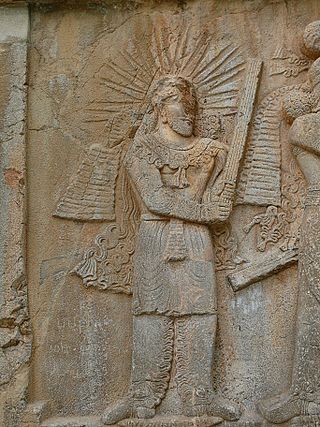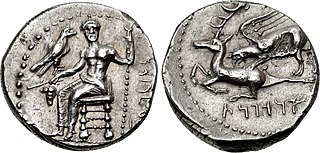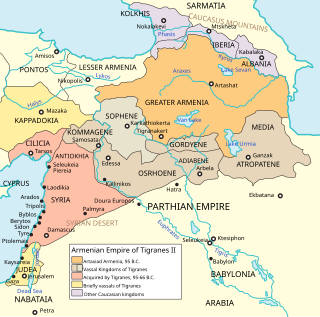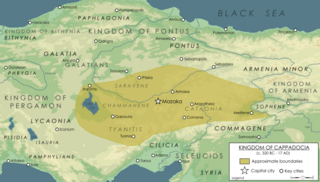
Zoroastrianism, also known as Mazdayasna and Behdin, is an Iranian religion. Among the world's oldest organized faiths, it is based on the teachings of Iranian prophet Zarathustra—commonly known by his Greek name Zoroaster—as set forth in the primary religious text called the Avesta. Zoroastrians exalt an uncreated and benevolent deity of wisdom, commonly referred to as Ahura Mazda, as the universe's supreme being; opposed to Ahura Mazda is Angra Mainyu, who is personified as a destructive spirit and the adversary of all things good. Zoroastrianism combines a dualistic cosmology of good and evil with an eschatology that predicts the ultimate triumph of Ahura Mazda over evil. Opinions vary among scholars as to whether the religion is monotheistic, polytheistic, henotheistic, or a combination of all three. Zoroastrianism influenced Iranian culture and history as well as ancient Western philosophy and the Abrahamic religions of Judaism, Christianity, and Islam.

Zarathushtra Spitama more commonly known as Zoroaster or Zarathustra, was an Iranian religious reformer who challenged the tenets of the contemporary Ancient Iranian religion, becoming the spiritual founder of Zoroastrianism. Variously described as either a sage, and/or a wonderworker; in the oldest Zoroastrian scriptures, the Gathas, which he is believed to have authored, he is described as a preacher and a poet-prophet. He also had an impact on Heraclitus, Plato, Pythagoras, and the Abrahamic religions, including Judaism, Christianity, and Islam.

Ahura Mazda, also known as Horomazes, is the creator deity and god of the sky in the ancient Iranian religion Zoroastrianism. He is the first and most frequently invoked spirit in the Yasna. The literal meaning of the word Ahura is "lord", and that of Mazda is "wisdom".

Mithra, commonly known as Mehr or Mithras among Romans, is an ancient Iranian deity of covenants, light, oath, justice, the sun, contracts, and friendship. In addition to being the divinity of contracts, Mithra is also a judicial figure, an all-seeing protector of Truth, and the guardian of cattle, the harvest, and the Waters.

Atropatene, also known as Media Atropatene, was an ancient Iranian kingdom established in c. 323 BC by the Persian satrap Atropates. The kingdom, centered in present-day northern Iran, was ruled by Atropates' descendants until the early 1st-century AD, when the Parthian Arsacid dynasty supplanted them. It was conquered by the Sasanians in 226, and turned into a province governed by a marzban ("margrave"). Atropatene was the only Iranian region to remain under Zoroastrian authority from the Achaemenids to the Arab conquest without interruption, aside from being briefly ruled by the Macedonian king Alexander the Great.

Atar, Atash, Azar or Dāštāɣni, is the Zoroastrian concept of holy fire, sometimes described in abstract terms as "burning and unburning fire" or "visible and invisible fire". It is considered to be the visible presence of Ahura Mazda and his Asha through the eponymous Yazata. The rituals for purifying a fire are performed 1,128 times a year.

Vishtaspa is the Avestan-language name of a figure appearing in Zoroastrian scripture and tradition, portrayed as an early follower of Zoroaster, and his patron, and instrumental in the diffusion of the prophet's message. Although Vishtaspa is not epigraphically attested, he is – like Zoroaster – traditionally assumed to have been a historical figure, although obscured by accretions from legend and myth.

The Kambojas were a southeastern Iranian people who inhabited the northeastern most part of the territory populated by Iranian tribes, which bordered the Indian lands. They only appear in Indo-Aryan inscriptions and literature, being first attested during the later part of the Vedic period.
Hydarnes, also known as Hydarnes the Elder, was a Persian nobleman, who was one of the seven conspirators who overthrew the Pseudo-Smerdis. His name is the Greek transliteration of the Old Persian name Vidṛna, which may have meant "he who knows the guilt/wrong".

The Farvahar (Persian: فَرْوَهَر, avestan: 𐬟𐬀𐬭𐬎𐬎𐬀𐬵𐬀𐬭𐬀, also known as the Foruhar or the Farre Kiyâni, is one of the best-known symbols of Zoroastrianism, an Iranian religion. There are various interpretations of what the Faravahar symbolizes, and there is no concrete universal consensus on its meaning. However, it is commonly believed that the Faravahar serves as a Zoroastrian depiction of the fravashi, or personal spirit.
Nora Elisabeth Mary Boyce was a British scholar of Iranian languages, and an authority on Zoroastrianism. She was Professor of Iranian Studies at the School of Oriental and African Studies (SOAS) of the University of London. The Royal Asiatic Society's annual Boyce Prize for outstanding contributions to the study of religion is named after her.

Ariaramnes, was the Ariarathid king of Cappadocia from 280 BC to 230 BC. He was the son and successor of Ariarathes II.

Ariarathes II, satrap and king of Cappadocia, son of Holophernes, fled into Armenia after the death of his uncle and adopted father Ariarathes I, ruler of Cappadocia. After the death of Eumenes he recovered Cappadocia with the assistance of Ardoates, the Armenian king, and killed Amyntas, the Macedonian satrap, in 301 BC, but was forced to accept Seleucid suzerainty. He was succeeded by Ariaramnes, the eldest of his three sons.

Ariarathes I was the last Achaemenid Persian governor (satrap) of the province (satrapy) of Northern Cappadocia, serving from the 340s BC to 331 BC. He led defensive efforts against the Macedonian invasion, commanded by Alexander the Great, and later fought at the Battle of Gaugamela under Darius III, the last King of Kings of the Achaemenid Empire. After the fall of the Achaemenid Empire, Ariarathes continued his resistance against the Macedonians, ruling concomitantly as an Achaemenid remnant and a precursor to the Kingdom of Cappadocia. He is regarded as the founder of the Iranian Ariarathid dynasty.

Apas is the Avestan language term for "the waters", which, in its innumerable aggregate states, is represented by the Apas, the hypostases of the waters.

The Kingdom of Sophene, was a Hellenistic-era political entity situated between ancient Armenia and Syria. Ruled by the Orontid dynasty, the kingdom was culturally mixed with Greek, Armenian, Iranian, Syrian, Anatolian and Roman influences. Founded around the 3rd century BCE, the kingdom maintained independence until c. 95 BCE when the Artaxiad king Tigranes the Great conquered the territories as part of his empire. Sophene laid near medieval Kharput, which is present day Elazığ.
Artasyrus was a Bactrian nobleman in the Achaemenid Empire, who was the father of Orontes I, the satrap of the Armenia and ancestor of the Orontid dynasty. The career of Artasyrus is obscure. According to the Greek historian Plutarch, he held the high-ranking office of the "King's Eye". He has been suggested be the same person as the namesake Iranian noble who participated in the Battle of Cunaxa in 401 BC. He and Orontes I are the only Bactrians who are known to have occupied high offices under the Achaemenid Empire. Bactrians that settled in other parts of the empire either did so by their own will or as garrison-colonists.

Zoroastrianism is a religion which has been practiced in the West Asian country of Armenia since the fifth century BC. It first reached the country during the Achaemenid and Parthian periods, when it spread to the Armenian Highlands. Prior to the Christianization of Armenia, it was a predominantly Zoroastrian land. The yazatas (deities) Mithra (Mihr) and Verethragna (Vahagn) particularly enjoyed a high degree of reverence in the country.

Cappadocia was a Hellenistic-era Iranian kingdom centered in the historical region of Cappadocia in Asia Minor. It developed from the former Achaemenid satrapy of Cappadocia, and it was founded by its last satrap, Ariarathes. Throughout its history, it was ruled by three families in succession; the House of Ariarathes (331–96 BC), the House of Ariobarzanes (96–36 BC), and lastly that of Archelaus (36 BC–17 AD). In 17 AD, following the death of Archelaus, during the reign of Roman emperor Tiberius (14–37 AD), the kingdom was incorporated as a Roman province.
The Ariarathid dynasty was a hereditary dynasty of Iranian origin.















